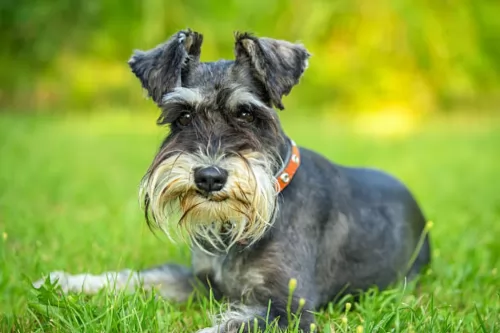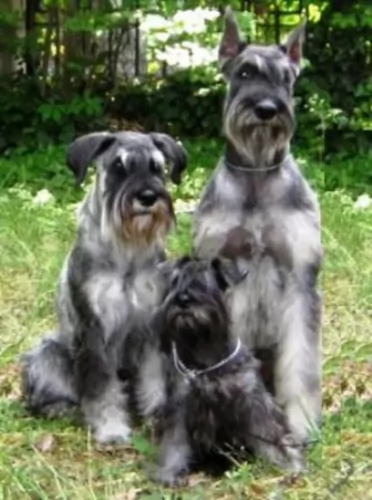 Petzlover
Petzlover Australian Terrier is originated from Australia but Schnauzer is originated from Germany. Australian Terrier may grow 25 cm / 9 inches shorter than Schnauzer. Australian Terrier may weigh 12 kg / 26 pounds lesser than Schnauzer. Both Australian Terrier and Schnauzer has almost same life span. Both Australian Terrier and Schnauzer has almost same litter size. Both Australian Terrier and Schnauzer requires Moderate Maintenance.
Australian Terrier is originated from Australia but Schnauzer is originated from Germany. Australian Terrier may grow 25 cm / 9 inches shorter than Schnauzer. Australian Terrier may weigh 12 kg / 26 pounds lesser than Schnauzer. Both Australian Terrier and Schnauzer has almost same life span. Both Australian Terrier and Schnauzer has almost same litter size. Both Australian Terrier and Schnauzer requires Moderate Maintenance.
 The Australian terrier, the little terrier, is a breed developed to control vermin. The nature of this dog is very spirited. They are alert, courageous and self-confident but still very human-friendly.
The Australian terrier, the little terrier, is a breed developed to control vermin. The nature of this dog is very spirited. They are alert, courageous and self-confident but still very human-friendly.
Australian terriers were breed by the mix of the Terrier with the rough coat and Scotch Dog of Great Britain. These breeds were mixed until they produced the muscular and fearless dog for the Australian settlers. Their primary job was to control the number of rodents and snakes. They were taught to tend flocks, be an excellent guard dogs but remain friendly. This breed is still very popular as a working dog, loyal companion and dogs for show, city, home or a farm.
 These dogs hail from Germany and are particularly well known for their stern faces and their facial hair - the mustache and eyebrows. You get 3 types of Schnauzer – the Miniature, Standard and Giant.
These dogs hail from Germany and are particularly well known for their stern faces and their facial hair - the mustache and eyebrows. You get 3 types of Schnauzer – the Miniature, Standard and Giant.
These dogs have always been used for their rat catching skills. The Standard Schnauzer is also known as Mittelschnauzer and they have been categorized as working dogs but also as Terriers.
They've always been good herders of livestock and have been regarded as a good all-round farm dog. Most Standard Schnauzers have earned American Kennel Club (AKC) herding titles. They also make excellent watchdogs.
A breed standard for this dog was written in 1880. Also, the Bavarian Schnauzer Klub was formed in Munich in 1907.
 The Australian terrier has body longer than they are tall. They are small dogs with the long and thick coat with silky undercoat and short little legs. This smart-eyes breed is perfect for persons who live indoors. But, you must know that they really like to bark and communicate that way with everybody. They also have a high need for activity so it will be necessary to take him out so he can run, play and be social with other dogs. They are very intelligent, but not very responsive. They will quickly learn how to fetch, but they will have days when they just feel like fetching.
The Australian terrier has body longer than they are tall. They are small dogs with the long and thick coat with silky undercoat and short little legs. This smart-eyes breed is perfect for persons who live indoors. But, you must know that they really like to bark and communicate that way with everybody. They also have a high need for activity so it will be necessary to take him out so he can run, play and be social with other dogs. They are very intelligent, but not very responsive. They will quickly learn how to fetch, but they will have days when they just feel like fetching.
 You get the miniature and giant Schnauzer as well as the Standard. The Standard Schnauzer stands at between 43 to 51cm and weighs between 14 and 20kg. The dog comes in different color variants - black, black and silver and a greyish color.They have wiry coats that don’t shed much.
You get the miniature and giant Schnauzer as well as the Standard. The Standard Schnauzer stands at between 43 to 51cm and weighs between 14 and 20kg. The dog comes in different color variants - black, black and silver and a greyish color.They have wiry coats that don’t shed much.
They are squarely and robustly built and a typical feature is the mustache, beard and significant eyebrows of the dog. The ears are set high and were once clipped but they are left floppy these days.
The tail has always been traditionally cropped to around three vertebrae,giving the dog a distinctive look, but now it is often left as is and is medium length and curls over the dog’s back.
The Schnauzie is a seriously intelligent dog and this makes them highly trainable so that he can obey quite a few commands. These dogs get bored easily and will require exercise and games that will stimulate him mentally and physically.
They’re alert too, and will bark in warning at any intruders, making them excellent watchdogs. Other notable characteristics are courage and stamina and they have been used for search and rescue work.
These dogs have strong personalities, and are inclined to be stubborn so you want to be sure that they are trained and socialized. This makes them more amicable to be around – they’re obedient and know their place.
 The Australian terrier is very good breed to choose if you have children. They are active and always ready to play, and they will protect the children since they have watchdog gene.
The Australian terrier is very good breed to choose if you have children. They are active and always ready to play, and they will protect the children since they have watchdog gene.
Excellent watch dog. This breed will keep your garden and home vermin free.
They are generally very polite towards strangers and highly adaptable among other dogs, but their adaptability in social life is totally up to the human and the training. They can grow to be adaptable dogs that fit well into almost any environment; city or country, house or apartment.
Since they are an intelligent breed, the Australian terrier may surprise you with their ability to learn new tricks and shock you with their ability to be very strong willed about doing what is told. It’s not that they are not the type to obey and be “a good dog”, they are so playful and silly that they will often forget that they are the god and not the human. You must start training them while they are still pups.
 Energetic, strong-willed and loyal, the Schnauzer can be an affectionate friend for children in the home as well as adults.
Energetic, strong-willed and loyal, the Schnauzer can be an affectionate friend for children in the home as well as adults.
He is cool towards strangers and he is also a bit snooty and aggressive with other dogs, but if he is brought up with them, he will show some loyalty and friendship towards them too.
 A bone disorder, where the hip joint starts to rot caused by decaying of the femur bone which is located in the dog’s hind limb.
A bone disorder, where the hip joint starts to rot caused by decaying of the femur bone which is located in the dog’s hind limb.
Luxating patella is a knee disease where one or both kneecaps can slip out of place.
Rupture of an important ligament in the knee (stifle) joints.
The brain disorder that is characterized by seizures. There are several different types of epilepsy that can affect dogs.
A chronic disease of the metabolism which is characterised as high glucose amount in the blood. This happens when hormone insulin drops below the normal values. This condition results in malfunction of vital organs.
 Schnauzers are very healthy dogs. Nonetheless even these dogs can succumb to some of the many dog illnesses there are.
Schnauzers are very healthy dogs. Nonetheless even these dogs can succumb to some of the many dog illnesses there are.
Hip dysplasia is a common dog ailment and the Schnauzer isn’t immune to it. Hip dysplasia can be very sad in dogs as it can cripple a dog, with painful arthritis being his lot as well. It is no comfort for dog owners to know that hip dysplasia is common in most dog breeds – they are devastated when their once playful dog is brought down by hip dysplasia and exhibits signs of stiffness and pain.
 Recommended daily amount is usually found on the type of the food you choose. They like dry food, and if you are not quite sure what brand of the dry food you should choose, seek a vet’s advice. The Australian terrier has a healthy appetite, but he almost never overeats. How much your Australian terrier eats depends on his size, age, metabolism, and activity level.
Recommended daily amount is usually found on the type of the food you choose. They like dry food, and if you are not quite sure what brand of the dry food you should choose, seek a vet’s advice. The Australian terrier has a healthy appetite, but he almost never overeats. How much your Australian terrier eats depends on his size, age, metabolism, and activity level.
Their coat requires moderate maintenance. That means that you don’t have to groom your Australian terrier every single day, but being aware of the importance of grooming him at least twice a week is a key because lack of adequate care may lead to skin diseases. Make sure not to bathe them too much, but you can be free with their haircut. They can grow very sharp toenails, so they should be clipped regularly. Ear and teeth must be kept clean.
Lots of outdoor activity. They are lovable kind, so don’t be reserved towards them. It’s important to begin training and socializing your pup as soon as possible. Training sessions need to be consistent, firm, short and clear. Grooming is a must since you will want to prevent the tangles and mats.
Find a place for them where you can take of the leash and let them run free. They love chasing birds, butterflies and anything that flies above. They will chase small rodents, other dogs and cats. After you thought you Australian terrier how to play with other dogs and cats, they will be the most wanted guest in the whole neighbourhood. Find a place where they can dig holes – and they will be so happy that they probably won’t hear you calling them home.
 Your Schnauzer will need to have his hair brushed twice a week as well as being professionally groomed. This is by hand-stripping or by clipping.
Your Schnauzer will need to have his hair brushed twice a week as well as being professionally groomed. This is by hand-stripping or by clipping.
Standard Schnauzers have lots of energy and will require adequate exercise every day – walks, ball games and runs off the leash.
Check his eyes and make sure there is no discharge. Check inside the ears and make sure there is no sign of redness and discharge. Look inside his mouth for rotting teeth. Bad teeth can cause lots of health problems with a dog, not just in terms of the teeth, but bad teeth can negatively affect other parts of the body too.
You want your Schnauzer to benefit from good food, after all nourishing food contributes to good health and longevity. If you choose to give your Schnauzer one of the commercially manufactured dog foods there are, make sure it is one of the better brands with more natural ingredients, The cheaper ones are filled with toxic ingredients.
Choose food according to his age, size and activity levels. To add some variety, feed him some home made food twice a week which can be added to his dry kibble. Boiled chicken, brown rice or pasta and spinach, sweet potatoes and carrots are a healthy choice for your pet. Try and include some raw meat into the diet. Ensure there is always a bowl of fresh, cool water for him.